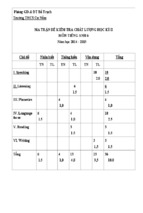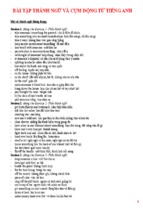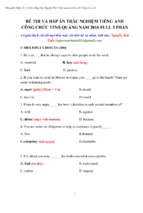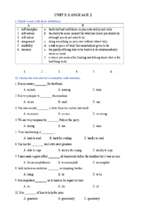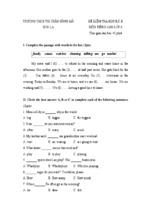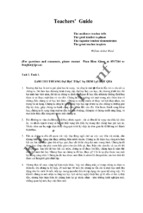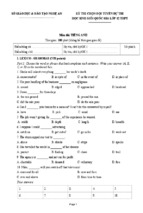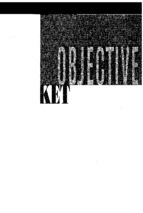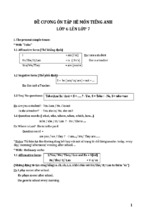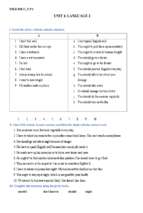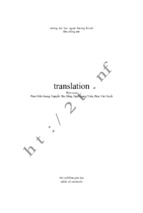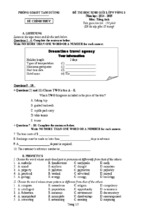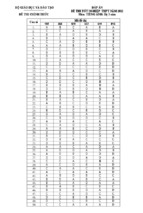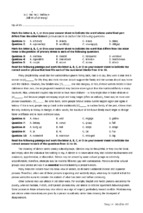Giáo trình Translation 1,2,3
trường đại học ngoại thương hà nội
khoa tiếng anh
translation
Biên soạn
Phan Hiền Giang, Nguyễn Thu Hằng, Ngô Quang Vịnh, Phan Văn Quyết
nhà xuất bản giáo dục
table of contents
Translation 1 (For intermediate learners)
Part 1. Social issues i
7
8
Unit 1. Education
Making college pay off
Nâng cao chất lượng giáo dục trong nền kinh tế đang chuyển
đổi
8
8
11
Unit 2. The dilemma that confronts the world
What counts in environment protection
UNDP góp phần loại bỏ các chất gây suy giảm tầng ôzôn ở
Việt nam
13
13
15
Unit 3. Social problems
Corruption – a tax of the worst kind
ò
ò
gia tăng
Unit 4. History and culture
Nguyen dynasty
Món ăn Việt nam
17
17
19
ò
22
22
23
Unit 5. Biology – the future industry
GMOs – the pros and cons
Khía cạnh đạo đức trong khoa học di truyền
26
26
27
check your progress 1
29
Part 2. Economics and International Trade
32
Unit 6. Trade pact offers hope
Trade pact offers hope
Ngoại trưởng Mỹ Albright muốn xúc tiến hiệp định thương
mại Việt Mỹ
Unit 7. Rethinking Asia after the crisis
33
33
35
38
2
The answer: deglobalize
Kiếm tìm động năng tăng trưởng mới
38
39
Unit 8. China – Deal of the Century
How Beijing can learn from its neighbours’ blunders
Trung Quốc – lợi và thiệt khi vào WTO
42
42
43
Unit 9. Is Globalisation desirable?
Advancing globalisation
Xu hướng toàn cầu hoá trong thiên niên kỷ mới
46
46
47
Unit 10. The Asian Century
Asia’s economy surviving the aftershock
Tình hình thương mại các nước Đông Nam á
50
50
51
check your progress 2
54
Translation 2 (For higher-intermediate learners)
56
Part 3. Social issues ii
57
Unit 11. Health and welfare
Moonlighting medicos in Vietnam
Đoàn kết chống lại bệnh AIDS
58
58
59
Unit 12. Tourism, land and people
The Saigon blues
Du lịch Việt nam
61
61
63
Unit 13. Agriculture
Would agriculture hold back the economy?
Nông nghiệp Việt nam trong quá trình đổi mới kinh tế
65
65
67
Unit 14. The digital age
How e-smart are you?
Công nghệ thông tin - cơ hội hơn là thách thức
69
69
70
3
Unit 15. The knowledge economy
Who owns the knowledge economy?
Tri thức là sức mạnh
73
73
74
check your progress 3
77
Part 4. corporate concerns
80
Unit 16. Culture in business
Dying to work
Quản lý tri thức phải xuất phát từ văn hoá doanh nghiệp
81
81
83
Unit 17. SMEs and the Private Sector
Small business discover its strength
Doanh nghiệp vừa và nhỏ – vấn đề và giải pháp
85
85
87
Unit 18. Foreign Direct Investment
Forms of FDI
Việt nam hoan nghênh sự trở lại của các nhà đầu tư
90
90
92
Unit 19. Marketing
No smoke without brand fire
Marketing ở các doanh nghiệp Việt nam
95
95
96
Unit 20. Corporate governance and SOE reforms
Corporate governance
Giảm biên chế DNNN – những bước đi ban đầu
98
98
100
CHECK YOUR PROGRESS 4
102
TRANSLATION 3 (For advanced learners)
104
part 5. politics and foreign affairs
105
Unit 21. International politics
106
4
Two great forces of our time
Khái quát về chính trị quốc tế
106
107
Unit 22. World’s Powers
Fading superpowers and new great powers
Liệu nước Mỹ có tiếp tục thống trị trong thiên niên kỷ mới?
110
110
112
Unit 23. Critical relations
U.S. policy turning toward Asia
Sự chia rẽ trong quan hệ Âu Mỹ
115
Unit 24. International organizations
Intergovernmental organizations
Hệ thống Liên hiệp quốc
119
119
121
Unit 25. Ready for tomorrow
Start me up
Thước đo thành công
124
124
check your progress 5
128
Part 6. money, Banking and finance
131
Unit 26. Financial Hubs
The foundation of stability
Quỹ Tiền tệ Quốc tế cần cải cách
132
132
Unit 27. Monetary union and the euro
Sleeping giant
Cuộc tranh luận xung quanh đồng euro
136
Unit 28. Modern banking
Online payments sideline banks
Ngành ngân hàng trong thế kỷ 21
140
140
141
115
116
125
133
136
137
5
Unit 29. Insurance
Vietnam’s thriving insurance market
Tạo ra một sân chơi bình đẳng cho các công ty bảo hiểm ở Việt
nam
144
144
145
Unit 30. Stock Market
A start nonetheless
Tiến tới một trung tâm giao dịch chứng khoán lành mạnh
148
148
149
check your progress 6
151
annex 1 Marking scheme
153
annex 2 English proverbs
154
6
translation 1
For intermediate learners of English
7
part i. social issues i
UNIT 1. EDUCATION
8
Task 1. Translate the following into Vietnamese
Making college pay off
1. College is an experiment in hope. It’s also a risky investment for us all. Whether it is
graduate or undergraduate school, a two-year program or an eight-year one, we entrust
time in our lives to school for both a new identity and a ticket to the outside world. We
come to college with unspoken anticipation of all that will be done for us. We expect to be
made acceptable, valuable, and finally employable in the eyes of the world. We also hope
that magic answers will be revealed to us through academic study, leading us to
guaranteed success in the outside world. By graduation or completion of our chosen
program, we presume everything will be clear; we will be made brilliant, and all
knowledge will be accessible to us.
2. I have been a consultant to countless people who all had faith in this magic - many of
whom were disappointed when the expected alchemy never took place. They discovered,
years later, that this powerful, magical process just doesn’t happen.
3. We have been all conditioned to wait for things to happen to us, instead of making things
happen. Most of us learned that we would excel, or at least pass, if we did the work
assigned to us by our teachers. We learned to find out what was expected to us, do it, and
wait for a response. After we took all the required courses, we were promoted, say, from
first to second year. But what did we really learn? System Dependency! We learned that
the person who knew the greatest number of right answers was rewarded by being the first
of her class.
4. Nothing like this happens in real life. Yet too many of us never recognize it. We are the
same passive students at ten or twenty five or forty four as we are at fourteen, continuing
the teacher-student dichotomy, which we automatically transfer to the employer-employee
relationship. And we found that though studying history or art or whatever might be
interesting, it alone didn’t lead to much else - like new experiences, contacts, or even a job.
5. Much disappointment resulted from this misuse of college. It’s time to retrain ourselves to
approach school in the same positive, productive, active way that successful people
approach life.
6. College can become all that you wished for - a time for learning, for broadening horizons,
a time to discover who you are and how you work with others, for setting goals and
making things happen. In short, college is a time for developing skills that will serve you
far beyond your college years, which, even more than your degree, will prepare you for
entrance into the real world.
7. So instead of thinking of college as a more difficult twelfth grade, learn to use college like
the real world. Step up and out of the suffocating box and stop pulling the lid tighter down
on your own possibilities. Remember, the longer you sit and wait, the harder it is to move
up. The passive “good student” attitude absolutely stifles any chance for people to become
motivated, impassioned, or connected to new ideas and network of people. Don’t be afraid
to make that extra effort. Doing only the minimum requirement is the grossest
misunderstanding of what college is all about!
9
Task 2. Vietnamization
When translating, it is more important to convey the message in the most natural way possible,
rather than stick to the English words or phrases. Look back at the examples from task 1:
College is an experiment in hope
Trường đại học là nơi ta gửi gắm bao hi vọng
The longer you sit, the harder it is to move up
Càng ngồi lâu thì sức ì càng lớn
Now try to Vietnamize the following sentences:
1. The rural women have to work very hard from morning till night.
2. Have a safe journey home!
3. It’s hard to overstate her beauty.
4. Time is what you make of it.
5. The sun also rises.
6. Your home away from home. (on the front door of a hotel)
7. Bacchus drowned more men than Neptune.
8. He talks to me as if there were nothing between us.
9. My new assistant is very efficient.
10. Unlike managers, leaders only use power as a last resort.
Task 3. Find the English equivalents to the following
nền kinh tế đang chuyển đổi
có trình độ học vấn cao
dân số trong độ tuổi lao động
biết đọc biết viết
số lượng người đi học
tăng trưởng toàn diện
xoá đói nghèo
phổ cập giáo dục tiểu học
giáo dục phổ thông cơ sở (cấp hai)
giáo dục trung học
giáo dục đại học
giờ học trên giảng đường
loại hình đào tạo
10
trường dân lập
trường bán công
Task 4. Translate the following into English
NÂNG CAO CHấT LƯợNG GIáO DụC TRONG
NềN KINH Tế ĐANG CHUYểN ĐổI
1. Việt nam có một trình độ học vấn khá cao với 91% số trẻ em từ 5 đến 10 tuổi được đi học
và 88% dân số trong độ tuổi lao động biết đọc biết viết. Tuy nhiên, khi đất nước bước vào
thiên niên kỷ mới, sự cạnh tranh từ các nước láng giềng Đông á sẽ đặt ra những thách thức
mới đối với hệ thống giáo dục và đào tạo của Việt nam.
2. Chính phủ Việt nam đã đặt ra những mục tiêu lớn nhằm tăng số lượng người đi học.
Nhưng Việt nam cũng phải đối mặt với những thách thức không nhỏ trong việc thực hiện
các chính sách giáo dục nhằm đảm bảo rằng hệ thống giáo dục sẽ cung cấp những kiến
thức và kỹ năng cần thiết đáp ứng nhu cầu của xã hội trong tương lai. Việt nam cần nỗ lực
rất nhiều, nhất là ở các vùng nông thôn, để phát triển nguồn vốn con người quí giá phục
vụ cho tăng trưởng toàn diện.
3. Thách thức lớn nhất đối với các nhà giáo dục Việt nam là làm sao đảm bảo được rằng hệ
thống giáo dục đào tạo thích ứng được với những yêu cầu mới của một nền kinh tế thị
trường đang phát triển. Việc mở rộng và hiện đại hoá hệ thống giáo dục đào tạo là những
nhân tố quan trọng trong chiến lược phát triển của chính phủ nhằm duy trì tăng trưởng
kinh tế và xoá đói giảm nghèo.
4. Mục tiêu của chính phủ Việt nam là cố gắng phổ cập giáo dục tiểu học vào năm 2005 và
phổ cập giáo dục phổ thông cơ sở vào năm 2010. Số sinh viên đại học năm 2005 dự tính có
thể tăng thêm 30% so với năm 2000 (hơn 450 000 sinh viên).
5. Để đạt được những mục tiêu trên, cần phải có sự thay đổi của cả cung và cầu về giáo dục.
Về cung, cần nâng cao chất lượng giáo dục. Muốn vậy phải nâng cao trình độ của đội ngũ
giáo chức và tăng lương cho họ, kéo dài giờ học trên giảng đường, và tạo điều kiện cho
giáo viên và học sinh được tiếp cận nhiều hơn với sách vở và các phương tiện giảng dạy.
6. Về cầu, người dân cần nhận thức được rằng lợi ích của giáo dục sẽ bù đắp lại được những
chi phí cho giáo dục, cả chi phí trực tiếp lẫn gián tiếp. Trên thực tế, cầu về giáo dục những
năm gần đây đã tăng đáng kể. Điều này được thể hiện bằng sự xuất hiện của hàng loạt các
loại hình và tổ chức giáo dục mới như trường bán công, trường dân lập, đại học mở...v.v....
11
UNIT 2. the dilemma that confronts the world
Task 1. Translate the following into Vietnamese
WHAT COUNTS IN ENVIRONMENT PROTECTION
1. When one American astronaut saw our planet earth from his spaceship, he remarked,
“It’s so, so vast, so beautiful.” His view of earth from outer space gave him a special
understanding of the natural treasures of our planet. Earth has oxygen in the air so that
creatures can breathe. It has fresh water and salt water to supply humans, animals, birds,
fish and plant life with the liquid they need to survive. It has a variety of soils in which
nutritious food can grow. It revolves around a sun that provides energy, light and heat.
Our air, water, soil, plant and animal life, and climate compose our natural environment,
which supports over 13 million different kinds of plant and animal species, including our
human race.
2. The study of the relationship between the human species and all the elements of the
natural environment is called ecology, which teaches us about the delicate balance of
nature in our home, the planet earth, and how we may upset that balance whenever we
alter the environment. Ecological studies reveal the damage we have done to our natural
home, some ways by which we could repair the damage, and some suggestions for
preventing similar damage in the future. Although we cannot return all of our
environment to its previous natural state, strict ecological control can preserve the
unspoiled places that still exist.
3. In an assessment on the future for the human race in the early part of the next century,
Klaus Topfer, the executive director of the UN environment programme, said that the
main threats to human survival were posed by water shortages, global warming and
worldwide nitrogen pollution. “Only by a massive increase in political will can a series of
looming crises and ultimate catastrophe be averted. We have the technology but we are not
applying it”, he said.
4. He described efforts to curb global warming as inadequate in comparison to the 60% cuts
required and added that the world was already suffering as a result of climate change
which was now unstoppable. Extreme weather events had left as many as 3 million people
dead in the last 5 years.
5. Full scale emergencies already exist, says the report: water shortages are hampering
developing countries; land degradation has reduced fertility and agricultural potential and
destruction of the tropical rain forests has gone too far to be reversed; many of the planet’s
species have already been lost or condemned to extinction; one quarter of the world’s
mamal species are now at significant risk of total extinction.
6. At sea, fisheries have been grossly overexploited and half of the world’s coral reefs are
threatened with destruction. Air pollution has reached crisis proportions in many cities
and it is too late to prevent global warming. It is the lack of government control that has
weakened the ability to solve problems. Dr Topfer said it was essential to force
multinational companies to be accountable for their actions and what they produce.
12
7. “The present course is unsustainable and postponing action is no longer an option.
Inspired political leadership and intense cooperation across all regions and sectors will be
needed to put both existing and new policy instruments to work,” the reports concluded.
Task 2. Emphasis - conversions and cleft sentences
Look back at the examples from task 1:
Only by a massive increase in political will can a series of looming crises and ultimate
catastrophe be averted.
Extreme weather events had left as many as 3 million people dead in the last 5 years.
What matters is being constructive and realising that where there is a political will, much can
be achieved.
It is the lack of government control that has weakened the ability to solve problems.
Translate the following into English, using the prompts given
Note
nhận thức cho người dân
phát thải khí nhà kính
tầng ôzôn
năng lượng thay thế
nhiên liệu hoá thạch
cạn kiệt
buôn bán động vật hoang dã
các loài có nguy cơ tuyệt chủng
công ước quốc tế về đa dạng sinh học
1. Chưa bao giờ miền quê nhỏ bé này phải hứng chịu một trận bão khủng khiếp đến như vậy.
(Never....)
2. Điều mà mỗi nước cần làm là nâng cao nhận thức cho người dân về tầm quan trọng của
việc bảo vệ môi trường. (What....)
3. Việc giảm thiểu phát thải khí nhà kính và bảo vệ tầng ôzôn không còn là trách nhiệm của
một quốc gia đơn lẻ nào nữa mà đã trở thành nhiệm vụ chung của cả loài người. (No
longer....)
4. Theo ước tính thì với mức tiêu thụ năng lượng như hiện nay và nếu không có sự phát triển
các nguồn năng lượng thay thế thì chỉ đến năm 2050 thôi, toàn bộ nhiên liệu hoá thạch
trên thế giới sẽ bị cạn kiệt. (... as early as ....)
5. Các công ước quốc tế về đa dạng sinh học đã tạo ra các công cụ pháp lý để kiểm soát việc
mua bán các động vật hoang dã trên thế giới. Tuy nhiên chính do nhu cầu đối với tài
nguyên thiên nhiên gia tăng đã làm cho việc suy giảm số loài sinh vật có nguy cơ tuyệt
chủng vẫn tiếp diễn. ( it is.....)
13
Task 3. Find the English equivalents to the following
loại bỏ
các chất gây suy giảm tầng ôzôn
tổng cục khí tượng thuỷ văn
giảm thiểu
hiện tượng phát thải khí CFCs
quỹ uỷ thác
nghị định thư
phó đại diện thường trú
đánh dấu một mốc quan trọng
ký (công ước)
hiện tượng nóng lên của trái đất
tái sử dụng
tái chế
ngành cơ điện lạnh
mục tiêu phát triển bền vững
biện pháp (mang tính) kinh tế
thủng tầng ôzôn
Task 4. Translate the following into English
UNDP GóP PHầN LOạI Bỏ CáC CHấT
GÂy SUY GIảM TầNG ÔZÔN ở việt nam
1. UNDP sẽ phối hợp chặt chẽ với Bộ Công nghiệp và Tổng cục Khí tượng thuỷ văn của Việt
nam thực hiện một dự án 15 tháng nhằm giảm thiểu hiện tượng phát thải khí CFCs trong
ngành cơ điện lạnh.
2. Dự án sẽ được quỹ uỷ thác của UNDP, Nghị định thư Montreal và Cơ quan Bảo vệ môi
trường của úc cung cấp gần nửa triệu đô la để xác định và thực hiện các biện pháp tái sử
dụng cũng như giảm thiểu phát thải CFCs một cách kinh tế.
3. Hôm nay ông Nicolas Roselini, phó đại diện thường trú UNDP, đã cùng ký dự án này với
ông Lê Quốc Khánh, thứ trưởng Bộ Công nghiệp. Ông Roselini nói: “Chúng tôi tin rằng
dự án này đánh dấu một mốc quan trọng cho việc loại bỏ các chất gây suy giảm tầng ôzôn
ở Việt nam.”
4. Năm 1994, Việt nam đã ký công ước Viên về bảo vệ tầng ôzôn và Nghị định thư Montreal.
Hai văn kiện này đều nhằm mục đích hạn chế và tiến tới chấm dứt việc sản xuất và sử
dụng các chất gây suy giảm tầng ôzôn.
5. Theo ước tính, chỉ riêng trong ngành cơ điện lạnh đã có khoảng 450 doanh nghiệp vừa và
nhỏ hiện đang sử dụng CFCs, một hoá chất có liên quan tới tình trạng suy giảm tầng ôzôn
và hiện tượng nóng lên của trái đất. Hàng năm, các doanh nghiệp này tiêu thụ trung bình
từ 300 đến 1500 kg CFCs.
14
6. Dự án sẽ phối hợp với các doanh nghiệp để tìm kiếm những cơ hội giảm thiểu các chất
phát thải với hiệu quả kinh tế cao nhất thông qua việc tái sử dụng. Dự án sau đó sẽ cung
cấp thiết bị và đào tạo chuyên môn cho một số doanh nghiệp để họ có thể thực hiện các
biện pháp đề ra.
7. Ông Roselini nói “Thành tựu này thực sự là bằng chứng cho thấy chúng ta có thể đạt được
mục tiêu phát triển bền vững - bảo vệ môi trường, đồng thời nâng cao hiệu quả kinh tế.”
15
unit 3. social problems
Task 1. Translate the following into Vietnamese
CORRUPTION - A TAX OF THE WORST KIND
1. Political and business leaders around the globe are today more than ever involved in
seeking common solutions to the problem of corruption. Popular theories of the 1970s,
which defended corruption as efficiency-enhancing, or at the very least a necessary evil,
have been debunked by a mountain of research demonstrating its corrosive impacts. These
include lost productivity, increased poverty, skewed public expenditure patterns and a
host of other downstream ills.
2. One study found that a country which improves its standing by two points on the 0-10
“corruption perception index”, created by the Berlin-based non-governmental
organisation Transparency International, will see its investment rate increase by 4% and
its GDP by about 0.5%. Another found that a strong correlation exists between high levels
of corruption and a poor-quality infrastructure, largely because insufficient funds are
devoted to operations and maintenance, which are less lucrative sources of illicit income.
3. More recent research has argued persuasively that not only does corruption impose a kind
of tax on both firms and citizens at large, it also tends to undermine the very institutions
upon which functioning markets depend. Property rights and impartial mechanisms for
enforcing commercial contracts are both imperilled when judges are for sale. If banks
regulators violate capital-adequacy norms, rationality in the allocation of credit is dealt a
fatal blow.
4. The persistent scale of worldwide corruption is a puzzle to many observers. At the
beginning of the 1990s, as former Soviet-bloc countries joined developing nations as
participants in WB and IMF market-oriented reform programmes, it seemed to many
economists that corruption was well on its way to being eliminated. By cutting onerous
regulations and thereby reducing the discretionary powers of officials, economic
liberalisation was supposed to tackle the root causes of corruption. Doing away with
artificial scarcities created by state-dominated economies, it was thought that bribe-taking
bureaucrats might become an endangered species.
5. Things didn’t quite turn out that way. Paulo Mauro, an IMF economist, argues that the
shift from command economies to free markets has created massive opportunities for the
appropriation of profits and has often been accompanied by “a change from a well
organised system of corruption to a more chaotic and deleterious one.”
6. Research into the politics of economic reforms in countries like India, Uganda and South
Africa suggests two very good reasons why liberalisation has not stamped out corruption
as originally hoped. First, the process of transferring assets and responsibilities from the
public to the private sector is itself an invitation to such forms of corruption as sweetheart
privatisation deals and lop-sided implementation of investment-promotion tax incentives.
7. The second reason stems from the continuous nature of reform programmes in most
developing and transitional economies. The initial “big-bang” reforms are usually followed
16
by an open-ended process in which governments tinker with alternative rules, experiment
with regulatory authorities, introduce corporate governance and so on. Reformers, in
short, have great discretion in determining how reform is to be implemented. Which
options they choose in each case has implications for major business groups.
8. The opportunities for corruption thus continue to evolve and in some cases far exceed the
possibilities during the era of state control. Even where reform decisions are taken
impartially, advance notice can be extremely valuable to private sector players, especially
when regulations governing capital markets are concerned. Continuous reform makes
inside information, in both timing and substance, a much sought-after commodity.
Task 2. Find the English equivalents to the following:
sự cách biệt giàu nghèo
gia tăng
biên soạn
nhà tài trợ
cơ quan chính phủ
tổ chức phi chính phủ
xoá đói nghèo
đồng bằng sông Hồng
phó vụ trưởng
tổng cục thống kê
điều tra
trung tâm thông tin khoa học
thương binh và xã hội
chịu thiệt thòi
vùng sâu vùng xa
cứ trong 5 người thì có 4 người...
miền Đông Nam bộ
khu vực Đồng bằng sông Cửu long
thu hẹp khoảng cách
nhiệm vụ quan trọng hàng đầu
Task 3. Translate the following into English
việt nam - phân hoá giàu nghèo đang gia tăng
1. Sự cách biệt giàu nghèo trong các tầng lớp dân cư Việt nam đang có chiều hướng gia tăng,
mặc dù nếu xét theo tiêu chuẩn quốc tế thì mức độ cách biệt này chưa phải là lớn. Kết luận
này được rút ra từ Báo cáo Phát triển của Việt nam năm 2002 do các cơ quan chính phủ,
các nhà tài trợ và các tổ chức phi chính phủ cộng tác biên soạn nhằm mục tiêu tiến tới xoá
bỏ tình trạng nghèo đói ở Việt nam.
2. Theo bản báo cáo, sự cách biệt giàu nghèo trên cả nước gia tăng chủ yếu là do mức độ
chênh lệch giữa nông thôn và thành thị tăng lên. Tăng trưởng của khu vực thành thị vượt
xa mức tăng trưởng của nông thôn ở mọi vùng, trừ vùng đồng bằng sông Hồng. Còn nếu
đem so sánh giữa các vùng giàu nhất và nghèo nhất Việt nam thì có thể thấy sự phân hoá
lại càng sâu sắc hơn.
17
3. Ông Nguyễn Phong, phó vụ trưởng Vụ Xã hội và Môi trường Tổng cục Thống kê cho biết,
trong khi thu nhập ở nông thôn tăng lên 30% thì thu nhập thành thị đã tăng lên với tốc độ
gấp đôi, thậm chí tới 4-5 lần tại các thành phố lớn. Theo điều tra của Tổng cục Thống kê,
cứ trong 5 người nghèo thì có 4 người sống bằng nông nghiệp.
4. Bà Hoàng Thuý Nhung, Trưởng Phòng Thống kê thuộc Trung tâm Thông tin Khoa học
Thương binh và Xã hội cho biết, sự chênh lệch lớn về thu nhập giữa thành thị và nông
thôn không chỉ đơn thuần là điều kiện sống mà còn ảnh hưởng nhiều đến các vấn đề việc
làm, y tế, giáo dục. Bản báo cáo nói trên ước tính một lần đến bệnh viện có thể làm cho
một người nghèo mất đi một số tiền tương đương 22% tổng chi tiêu cho lương thực của họ
trong một năm.
5. Mặc dù tỉ lệ học sinh đến trường đã tăng cao, song còn rất nhiều vùng, nhiều nhóm người
ở nông thôn phải chịu thiệt thòi so với thành thị trong việc tiếp cận giáo dục cơ bản. Theo
báo cáo nói trên, chi tiêu cho học tập ở thành thị bình quân cao gấp khoảng 10 lần khu vực
nông thôn. Tại các vùng núi, vùng sâu vùng xa, việc học tập càng khó khăn hơn. ở Lai
châu, chỉ có 49% phụ nữ trưởng thành biết chữ.
6. Sự tăng trưởng khác nhau theo từng vùng cũng là một nguyên nhân làm rộng thêm hố
ngăn cách giàu nghèo. Bản báo cáo cho biết trong giai đoạn 93-99, vùng phát triển mạnh
nhất là miền Đông Nam bộ với tốc độ kỷ lục là 78%. Còn vùng phát triển chậm nhất là
khu vực Đồng bằng sông Cửu long với tốc độ 18%.
7. Do đó, hạn chế diễn biến phân hoá giàu nghèo và tiến tới thu hẹp khoảng cách giữa nông
thôn và thành thị đang trở thành một trong những nhiệm vụ quan trọng hàng đầu của
Việt nam trong quá trình hoạch định và triển khai chiến lược phát triển kinh tế xã hội
trong thời gian tới.
Task 4. Describing trends
To avoid repetition and to show that you have a wide range of vocabulary, one word in
Vietnamese can be translated differently into English.
Look back at the examples from task 3:
Sự cách biệt giàu nghèo đang gia tăng
The rich-poor gap is widening
mức độ chênh lệch giữa nông thôn và thành thị ngày càng gia tăng
the worsening discrepancy between urban and rural areas
What are the other verbs that are used to describe upward or downward trends?
Complete the following table
Table 1. Intransitive verbs
Increase
Decrease
18
What are the adjectives used to describe the characteristics of the trends?
Complete the following table
Table 2. Maximizers and minimizers
Maximizers
Considerable
Minimizers
Slight
19
UNIT 4. History and culture
Task 1. Translate the following into Vietnamese
Nguyen Dynasty ( 1802-1945 )
1.
Emperor Gia Long initiated what historian David Marr has called “a policy of massive
reassertion of Confucian values and institutions” in order to consolidate the dynasty’s
shaky position by appealing to the conservative tendencies of the elite, who had felt
threatened by the atmosphere of reform stirred up by the Tay Son Rebels.
2.
Gia Long also began a large-scale program of public works (dikes, canals, roads, ports,
bridges and land reclamation) to rehabilitate the country, which had been devastated by
almost three decades of warfare. The Mandarin Road linking Hue to both Hanoi and
Saigon was constructed during this period, as were a string of star-shaped citadels – built
according to the principles of the French military architect Vauban – in provincial
capitals. All these projects imposed a heavy burden on the Vietnamese population in the
forms of taxation, military conscription and the forced labour.
3.
Gia Long’s son, Emperor Minh Mang, worked to consolidate the state and establish a
strong central government. Because of his background as a Confucian scholar, he
emphasized the importance of traditional Confucian education, which consisted of
memorisation and orthodox interpretation of the Confucian classics and texts of ancient
Chinese history. As a result, education and spheres of activity dependent on it stagnated.
4.
Minh Mang was profoundly hostile to Catholicism, which he saw as a threat to the
Confucian state, and he extended this antipathy to all Western influences. Seven
20
- Xem thêm -

